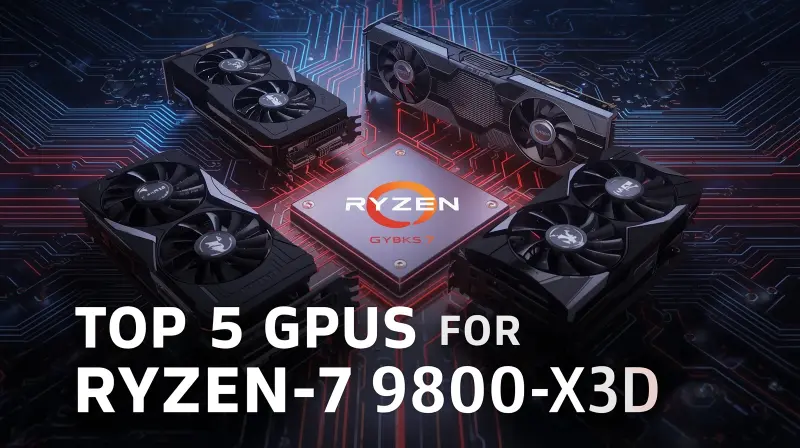Have you just secured the powerhouse Ryzen 7 9800X3D for your new build? Congratulations, you have the core of a top-tier gaming rig. But that incredible processing power means nothing if it’s paired with the wrong graphics card.
Choosing a GPU that can keep up without bottlenecking your system is crucial. This guide breaks down the top contenders for 2025-26, helping you find the absolute best gpu for ryzen 7 9800x3d to unlock maximum performance and breathtaking visuals.
List of NEW GPUs for Ryzen 7 9800X3D
Finding the right match for your CPU is about balancing performance, resolution, and budget. Whether you’re a high-refresh esports player or a 4K single-player enthusiast, one of these video cards will deliver the power you need.
1. Asus GeForce RTX 5070 Ti Graphics Card – 1440p Gaming
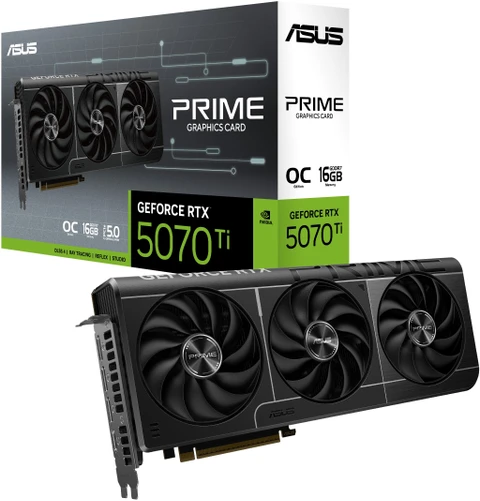
| Specification | Description |
| Architecture | Blackwell (GB203) |
| VRAM | 16 GB |
| Power Connector | 12V 2×6 |
| TDP | 300W (Asus Prime model) |
| MSRP | $750 |
Overview of the RTX 5070 Ti
The RTX 5070 Ti is positioned as a powerful option for gamers who demand excellence at 1440p resolution.
It leverages the new Blackwell architecture to deliver significant improvements in Ray Tracing and AI-driven tasks over its predecessors. This makes it a compelling choice for players who want to experience the latest visual technologies without compromise.
While it is technically capable of 4K gaming, its real strength lies in pushing extremely high frame rates at 1440p or for competitive esports titles at 1080p. It is designed to be a more sensible high-end option compared to the flagship cards.
Nvidia’s decision not to release a Founders Edition model means all cards are from board partners. This card offers substantial generational gains in AI benchmarks, showcasing its power beyond just gaming.
Experts Take on the RTX 5070 Ti
Reviewers find the RTX 5070 Ti to be a much better value proposition than the overpriced RTX 5080. However, the launch has been frustrating. Experts note that Nvidia seems to be reversing the trend of new cards offering a huge power jump for the same price.
They warn that low stock and immediate scalper pricing could push its cost well over $1,000. The general advice from critics is to be cautious, as the performance uplift over the last generation may not justify the chaotic launch price. A good GPU for 9800x3d requires not just power, but availability.
| Pros | Cons |
| Strong 1440p high-refresh-rate performance | Underwhelming performance uplift (9%) over 4070 Ti Super |
| Significantly better value than the RTX 5080 | Launch plagued by low stock and scalper pricing fears |
| Improved Ray Tracing and AI capabilities | Fails to match the performance of the last-gen RTX 4080 |
| Respectable 15% lead over the last-gen 4070 Ti | No Founders Edition model available |
2. Sapphire Radeon RX 9070 XT Graphics Card – Budget GPU for Ryzen 7 9800x3d
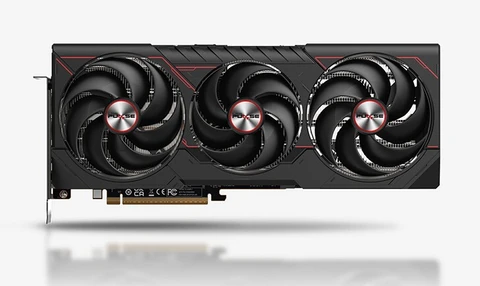
| Specification | Description |
| Architecture | RDNA 4 (TSMC N4C Process) |
| VRAM | 16 GB GDDR6 |
| Compute Units | 64 |
| TBP (Total Board Power) | 305 Watts |
| Display Connectors | DisplayPort 2.1a (UHBR 13.5) |
| MSRP | $599 |
Overview of the RX 9070 XT
The Radeon RX 9070 XT is a new RDNA 4 GPU, launched with a competitive $599 price point and 16 GB of memory, aimed squarely at high-performance gaming.
Its primary use is for gamers who want exceptional performance in traditional rasterization. In this area, it nearly matches the much more expensive RTX 5070 Ti and is a clear winner in value and power, especially for ultra HD gaming.
A standout feature is its 16 GB VRAM buffer, providing a significant advantage over the 12 GB offered by some competitors, which helps prevent stutters in demanding titles. The architecture also includes beefed-up ray tracing and AI accelerators, showing a significant generational leap for AMD, even if it still trails Nvidia in heavily path-traced games.
The RX 9070 XT is declared a winner by experts, earning the title of “Least Crap GPU of 2025 Award” for its insane price-to-performance ratio. Reviewers strongly recommend spending the extra money for the XT model over the non-XT, as it delivers a substantial performance boost for a small price increase. This card is seen as a strategic move by AMD, capitalizing on a market hungry for value while competitors focus on higher-margin AI products.
| Pros | Cons |
| Excellent price-to-performance and overall value | Poor performance in productivity and machine learning tasks |
| Nearly matches the RTX 5070 Ti for $150 less | High power usage with transient spikes up to 426 watts |
| Generous 16 GB VRAM is ideal for ultra HD gaming | FSR upscaling can appear shimmery with ghosting in some games |
| Represents a solid generational leap in performance | Frame pacing issues (poor 1% lows) in some Vulkan benchmarks |
| Major improvements in ray tracing and AI capabilities | Falls substantially behind Nvidia in heavily path-traced games |
3. MSI GeForce Gaming TRIO RTX 5090 Graphics Card

| Specification | Description |
| Architecture | Blackwell |
| PCB Design | Split PCB |
| Power Draw | 575W – 600W |
| Price | Extremely high |
Overview of the RTX 5090
The RTX 5090 is Nvidia’s flagship consumer GPU, built for those who demand the absolute best performance with no compromises.
This card is an engineering feat, featuring a sophisticated cooling system and a unique split PCB design. Its primary purpose is to deliver the highest possible frame rates in 4K and even 8K gaming, especially with all Ray Tracing features enabled.
The power requirements are enormous, necessitating a robust power supply and excellent case airflow. It represents the peak of what the Blackwell architecture can offer, pushing graphical fidelity and performance to new limits for the enthusiast market.
However, its launch has been marred by significant problems. Critical issues like black screening and the potential for its power connector to melt have created a negative perception that has impacted the entire 50 series lineup.
Experts Take on the RTX 5090
Critics have been harsh on the RTX 5090, viewing its troubled launch as a sign that Nvidia is prioritizing its highly profitable AI business over its core gaming audience. The card’s “ridiculously huge amount of money” and severe inventory shortages make it inaccessible to almost everyone. The launch set a negative tone for the entire generation. Reviewers argue it’s a clear example of prioritizing shareholders over gamers, making it a product that’s hard to recommend despite its power.
| Pros | Cons |
| Potentially the most powerful consumer GPU | Extremely high price point |
| Advanced cooler design | Launch plagued by black screen problems and severe shortages |
| Massive power draw (up to 600W) | |
| Potential for melting 12v 2×6 power connector |
4. Sapphire Radeon RX 7800 XT Graphics Card
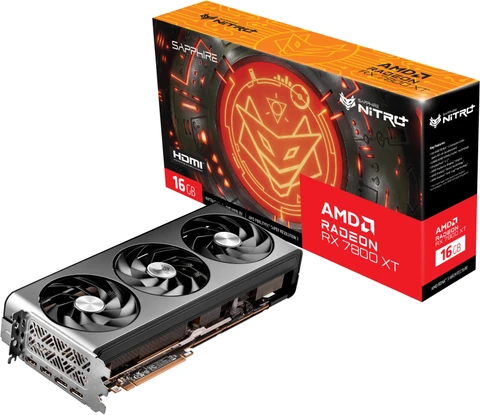
| Specification | Description |
| Architecture | RDNA 3 |
| VRAM | 16 GB |
| Price | Typically just over $500 |
| Launch | Roughly 1.5 years before 50 series |
Overview of the RX 7800 XT
Though it’s a previous-generation card, the RX 7800 XT remains a top recommendation for its incredible value.
This GPU delivers fantastic 1440p gaming performance that can still compete with newer, more expensive cards. Its main draw is providing a 16 GB VRAM buffer at a price point where competitors often offer less, future-proofing your build for upcoming games.
It is the ideal choice for builders who want a very good GPU without paying the premium for the latest technology. In some cases, its raw rasterization power has even been shown to outperform newer cards in specific titles, highlighting its longevity and efficiency.
This is a testament to strong design, offering a balanced and powerful gaming experience for a reasonable price. It represents the smart choice for system builders focused on performance per dollar.
Experts Take on the RX 7800 XT
The consensus among experts is clear: the RX 7800 XT is currently the “best bang for the buck” on the market around the $500 mark. It is praised for providing a robust 16 GB of VRAM without the high cost of newer options. Its continued availability and strong performance make it a compelling alternative to the poor generational value offered by some RTX 40 and 50 series cards. It’s the champion for builders who prioritize smart spending.
| Pros | Cons |
| Best value GPU around the $500 price point | An older generation card (RDNA 3) |
| Provides 16 GB VRAM at a competitive price | Pricing may not be as favorable in all regions |
| Can outperform newer, more expensive cards in some titles | |
| Widely available at a good price |
5. Zotac GeForce RTX 5070 12 Gb Graphics Card
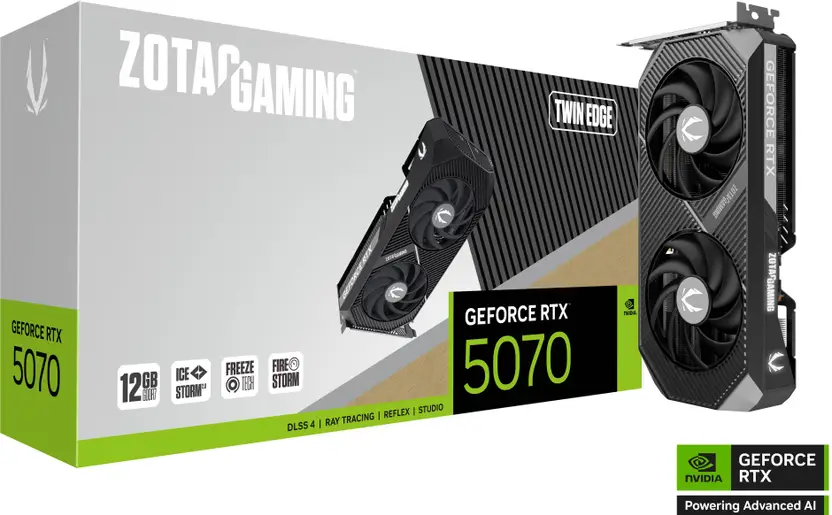
| Specification | Description |
| Architecture | Blackwell (GB205) |
| VRAM | 12 GB GDDR7 |
| Bus | 192-bit |
| TDP | 250W |
| MSRP | $550 |
Overview of the RTX 5070
The RTX 5070 is a compact, dual-slot GPU designed to bring Blackwell features to a more mainstream price point.
It’s marketed as a major upgrade, with Nvidia’s CEO claiming it can match an RTX 4090. However, this comparison relies heavily on AI-driven Multi-Frame Generation technology rather than raw performance. Its true rasterization power is much more modest, often landing on par with the previous generation’s RTX 4070 Super.
This card shines in specific areas. Its updated media engine performs well in video editing, and it sees a significant uplift in AI-related tasks. Its sleek and short Founders Edition design is also a major plus for builders working in smaller cases.
The biggest concern is its 12 GB of VRAM. This limited memory buffer may become a bottleneck for future games, especially at 4K resolution, making its value proposition questionable against competitors offering 16 GB.
Experts Take on the RTX 5070
Reviewers often call the RTX 5070 a “4070 Super in disguise.” While not inherently a bad card at MSRP, its value is weak. The limited generational leap in gaming performance and the 12 GB VRAM are major points of criticism, especially with AMD’s RX 9000 series offering more for a similar price. The consensus is that this card targets gamers who prioritize high frame rates achieved through AI upscaling over pure performance, and its success will depend heavily on market availability and actual street price.
| Pros | Cons |
| Compact, true two-slot Founders Edition design | A single-board design may avoid black screen issues |
| Strong performance gains in AI and media encoding | 12 GB VRAM is a major concern for future games |
| Modest performance-per-dollar improvement if found at MSRP | Runs hot despite a lower power budget |
| Single board design may avoid black screen issues | Poor value proposition compared to AMD competition |
Frequently Asked Questions
Is more VRAM important for the Ryzen 7 9800X3D?
Yes, VRAM is becoming increasingly important. The Ryzen 7 9800X3D is powerful enough for high-resolution gaming at 1440p and 4K, where modern games can use more than 12 GB of VRAM. Choosing a card with 16 GB, like the RX 9700 XT or RX 7800 XT, can prevent stuttering and provide a smoother experience in demanding titles, making it a wise investment.
Will a weaker GPU bottleneck the Ryzen 7 9800X3D?
Absolutely. A powerful CPU like the 9800X3D can process game data far faster than a weak GPU can render it. This creates a bottleneck, where your expensive CPU is waiting on the GPU, and you don’t get the high frame rates you paid for. Pairing it with a capable card like the ones listed here ensures a balanced system where both components can perform at their best.
Should I wait for new GPUs to be released?
The expert advice on several of the new 50 series launches was “don’t buy a high-end graphics card right now” due to poor availability and high prices. If you can wait, prices may stabilize. However, cards like the RX 9700 XT and RX 7800 XT currently offer such strong value that they are excellent choices if you need to build or upgrade today.
Final Thoughts
Choosing the right partner for your new CPU is the final step to building an amazing PC. For pure gaming value in 2025, the AMD RX 9700 XT stands out with its incredible rasterization performance and generous VRAM for its price.
If you prioritize Ray Tracing and have a slightly higher budget, the RTX 5070 Ti is a powerful 1440p contender.
By matching the card to your resolution and budget, you will find the best gpu for ryzen 7 9800x3d and create a perfectly balanced gaming machine.
Aveloria Thessar, based in California, USA, is Head Content Editor at BestGuides.in and a lead hardware reviewer with 8+ years of hands-on experience in building and benchmarking PCs. She began assembling her first PC in high school, sparking a lifelong passion for graphics cards, high-performance CPUs, gaming laptops, and SSDs. Over the years, Aveloria has tested dozens of components, running repeatable benchmarks to deliver accurate, practical insights. She shares her expertise through detailed guides and reviews, helping enthusiasts make confident, informed decisions, while actively contributing to tech communities and professional networks to stay at the forefront of PC hardware trends.
